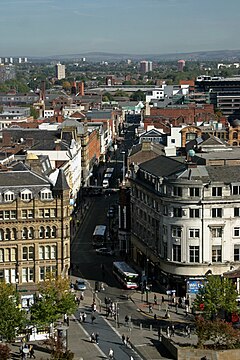Northern Quarter (Manchester)
| Northern Quarter | |
|---|---|
 |
|
| Northern Quarter shown within Greater Manchester | |
| OS grid reference | SJ844984 |
| Metropolitan borough | |
| Metropolitan county | |
| Region | |
| Country | England |
| Sovereign state | United Kingdom |
| Post town | MANCHESTER |
| Postcode district | M1, M4 |
| Dialling code | 0161 |
| Police | Greater Manchester |
| Fire | Greater Manchester |
| Ambulance | North West |
| EU Parliament | North West England |
| UK Parliament | |
The Northern Quarter (N4 or NQ) is an area of Manchester city centre, England, generally marked out between Piccadilly, Victoria and Ancoats, and centred on Oldham Street, just off Piccadilly Gardens. It was an invention of the 1990s, defined and named as part of the regeneration and gentrification of Manchester.
A centre of alternative and bohemian culture, the area is usually considered to be contained within Newton Street (borders with Piccadilly Basin), Great Ancoats Street (borders with Ancoats), Back Piccadilly (borders with Piccadilly Gardens) and Swan Street/High Street (borders with Shudehill/Arndale). Popular streets include Oldham Street, Tib Street, Newton Street, Lever Street, Dale Street, Hilton Street and Thomas Street.
Although the town of Manchester existed from medieval times (and had previously been the site of a Roman settlement), the area now designated as the Northern Quarter was not fully developed until the late 18th century.
The area now between Shudehill and Victoria Station was first built upon in the 14th century, as the village of Manchester expanded as a local centre for the wool trade. The expansion of the area was gradual up to the mid-18th century, when Manchester markedly increased in size and significance with the onset of the Industrial Revolution.
In the early 18th century, Oldham Street was apparently "an ill-kept muddy lane, held in place on one of its sides by wild hedgerows". The first town directory of Manchester, published in 1772, lists a number of buildings on Tib Street and Oldham Street. By the time of a map by William Green in 1794, the whole of the Northern Quarter is shown as a developed urban district.
It might be supposed that Oldham Street is so named because it links to Oldham Road but this is not the case as Oldham Street predates Oldham Road which was named Newton Lane in the 18th century. Oldham Street is probably so named because one of its first buildings was the house of Adam Oldham, a wealthy feltmaker and associate of John Wesley, who owned the land along which the street ran, and probably paid to have it surfaced for the first time.
...
Wikipedia

